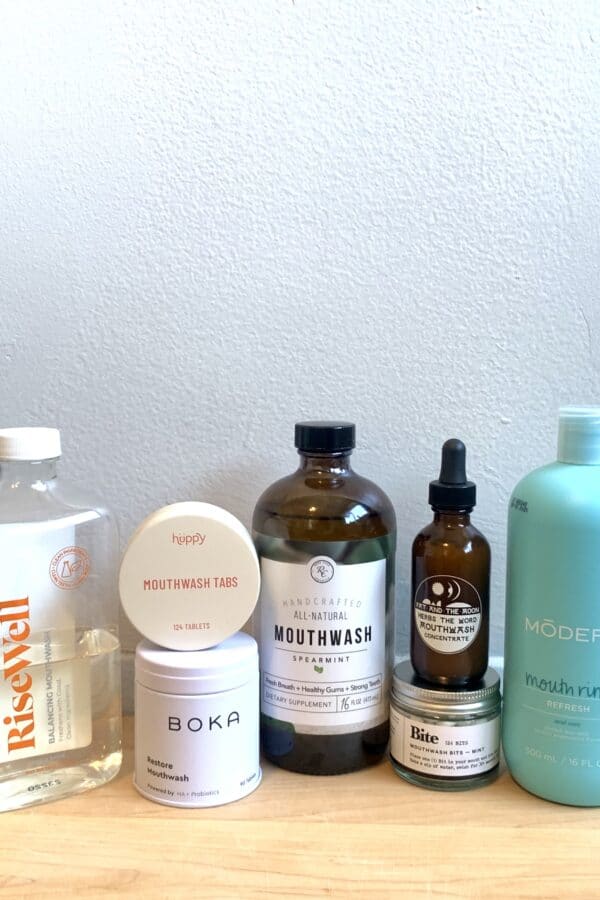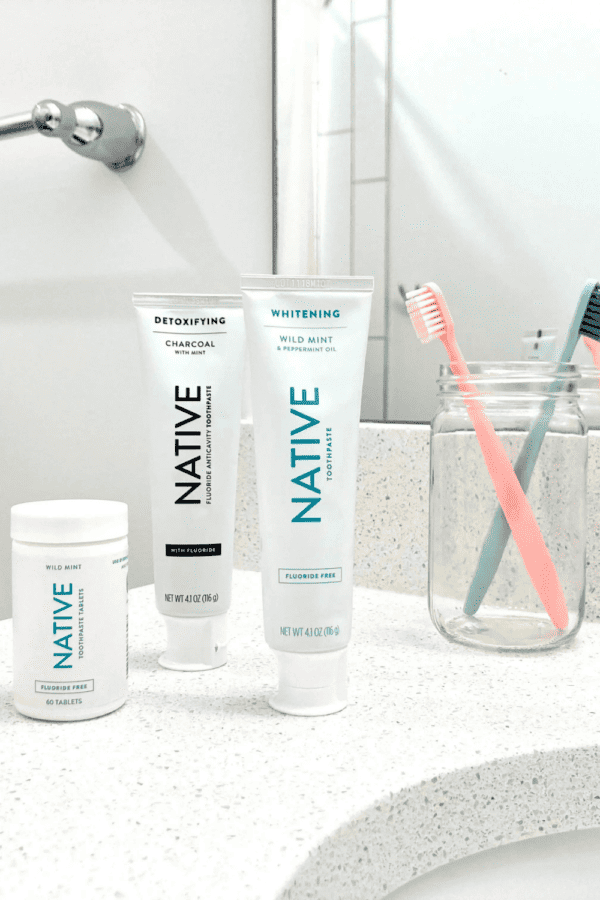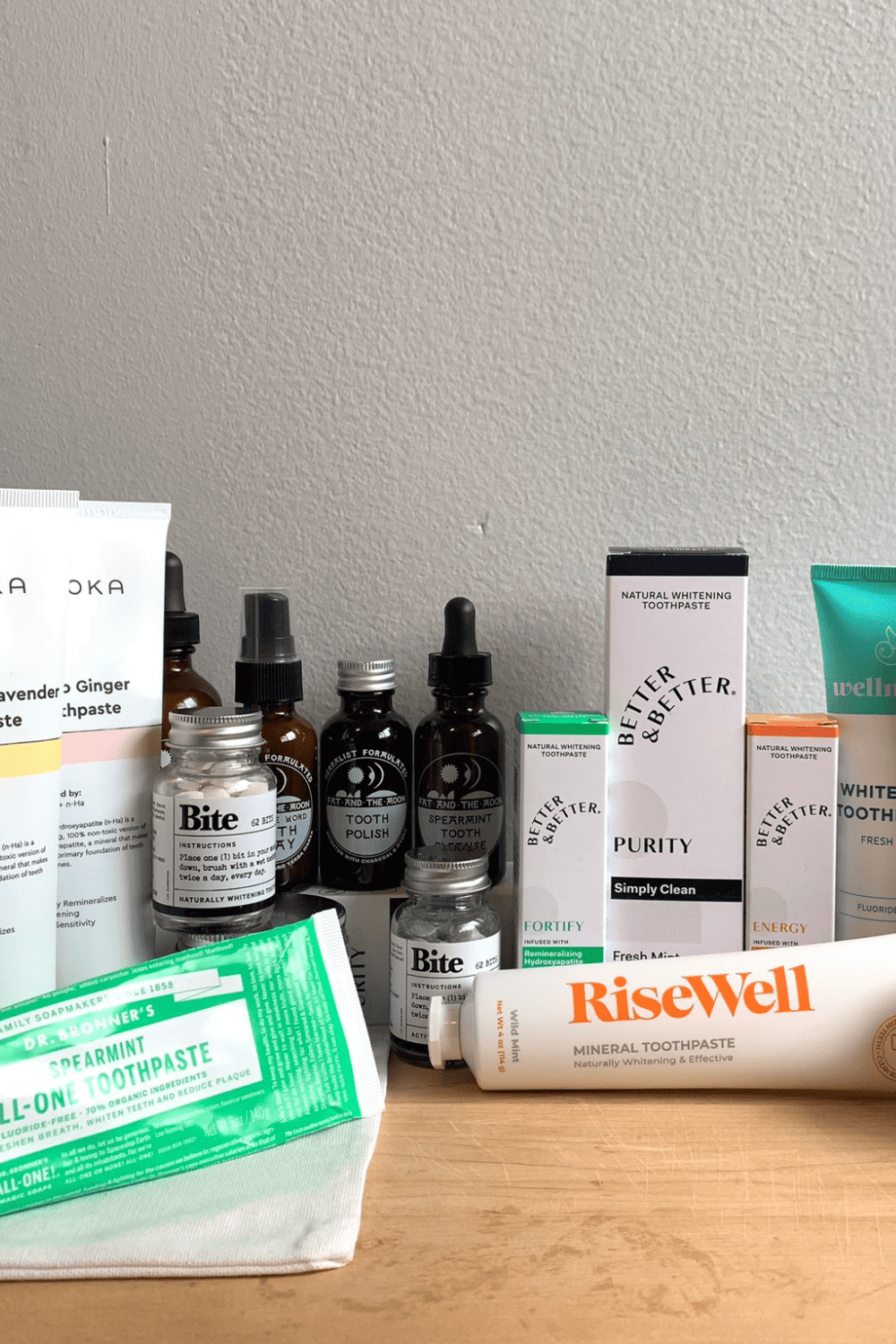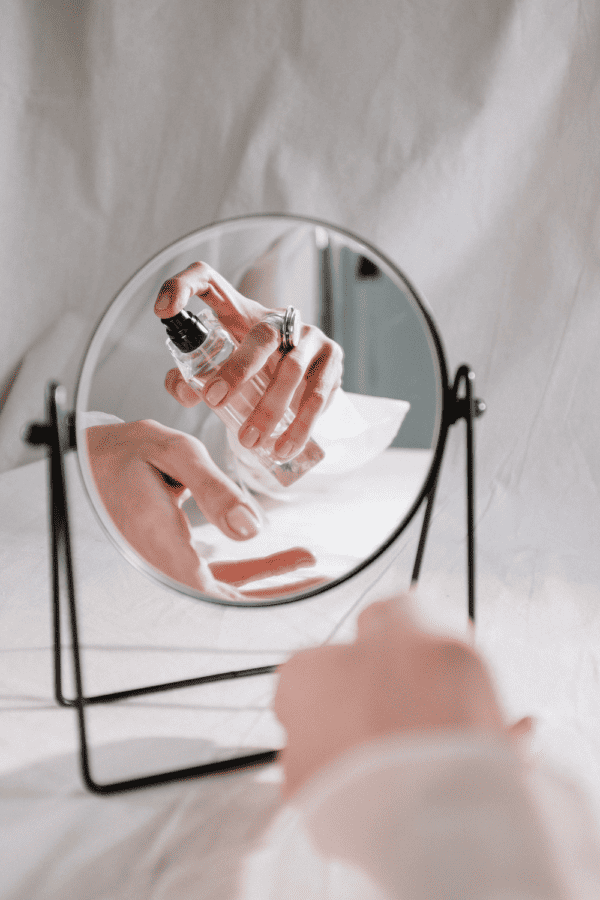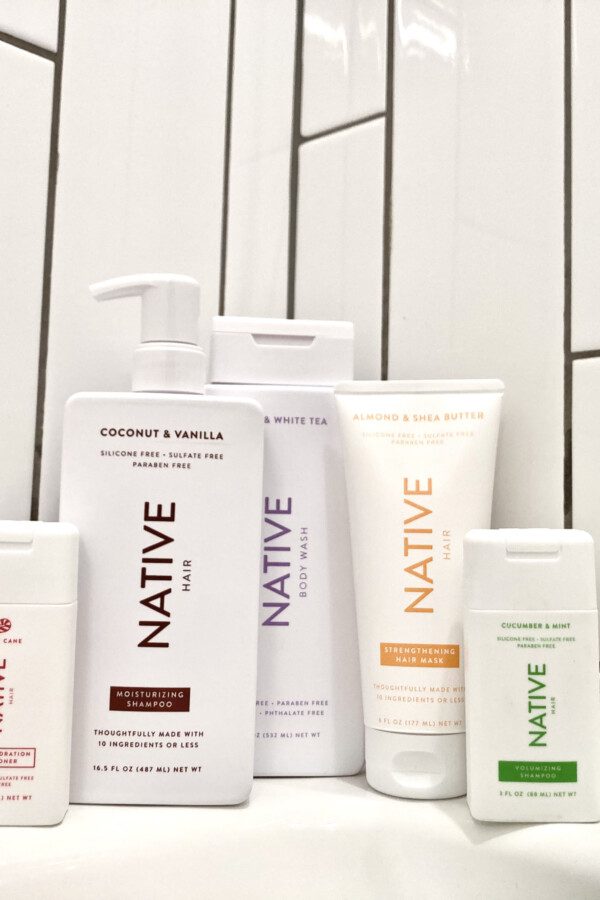In a Nutshell:
- ‘Conventional’ toothpaste brands contain several potentially problematic ingredients, including fluoride, artificial colors, cetylpyridinium chloride, and SLS.
- Hydroxyapatite is just as effective as fluoride in remineralizing teeth and preventing cavities… But it is much safer. (It also helps with whitening and sensitivity, too!)
- In addition to hydroxyapatite, safer toothpaste brands will utilize things like like coconut oil, baking soda, xylitol, and other natural ingredients that are more supportive of a healthy oral microbiome.
- Scroll down for even more info about how to foster a healthy oral microbiome for holistic health!
Table of Contents
- Harmful Chemicals in Conventional Toothpaste
- The Great Fluoride Debate
- Hydroxyapatite for Safer Cavity Prevention
- Other Natural Ingredients to Look for in Safer Toothpaste Brands
- Can Non-Toxic Toothpaste Whiten Teeth?
- What’s the Best Natural Toothpaste for Sensitive Teeth?
- What’s the Best Natural Toothpaste for Kids?
- Other Practices for a Healthy Oral Microbiome
- WE REVIEWED the Best Non-Toxic Toothpaste Brands on the Market
This article contains a few affiliate links, which means we may earn a commission if you decide to make a purchase.
Harmful Chemicals in Conventional Toothpaste
First, let’s talk about the ingredients to avoid in toothpaste:
- Artificial colors are obviously used for appearance, but they’re completely unnecessary. Most of them are derived from petroleum and some of them have use restrictions due to their carcinogenic properties. For example, the classic “Crest Scope Outlast” toothpaste uses Blue 1, which comes with a variety of potential concerns. It’s just not necessary to include it in our oral care products.
- Cetylpyridinium chloride is another ingredient you’ll find in Crest Scope Outlast toothpaste. It’s a “quat” which essentially means it has antibacterial properties. While that initially may sound like a good thing, quats can disrupt your healthy oral microbiome (which is needed for overall health!) and can contribute to general antibiotic resistance.
- Fluoride (we’ll get into this in a minute!)
- Sodium Lauryl Sulfate (SLS) is a common ingredient in many conventional toothpaste brands. It is a foaming agent that helps create a lathering effect. While SLS is not necessarily “toxic,” it is a skin-irritant. That means folks who are prone to sensitive skin could experience irritation from it. It’s worth noting here that your toothpaste does not have to foam in order to get your teeth clean. Even though we may be used to the idea of foaming, it’s not technically necessary.
- Unspecified “flavor” is used as… you guessed—flavor! Similar to how unspecified “fragrance” is used in personal care and cleaning products, “flavors” and “aromas” can indicate a lack of ingredient transparency. There is a long list of different ingredients that can be included under the “natural flavors” umbrella, and many brands don’t disclose what those ingredients actually are. When possible, look for brands that list the actual ingredients instead of just “natural flavors.”
What about triclosan?
Triclosan is an antibacterial agent that used to be used in many toothpaste brands. It has been associated with potential health and environmental risks, including antibiotic resistance, hormone disruption, and negative effects on aquatic ecosystems.
There is some good news here, though. In 2016, triclosan was banned from many soap-based products in the U.S. Even though it was technically not banned in toothpaste, many companies saw the writing on the wall and removed it from their formulations voluntarily. So, although you should still watch out for it, it’s much less common in oral care these days.
Are essential oils good in toothpaste?
You’ll notice that a lot of natural toothpaste brands use essential oils in their formulations—either for taste, to freshen breath, or as a cleaning agent.
Now, in general, these ingredients are pretty safe. But there are two things you may want to be mindful of:
- Depending on the strength and the type of essential oils used, some essential oils may disrupt your oral microbiome. A disrupted oral microbiome over long periods of time could contribute to or lead to significant downstream effects, including cancer, heart disease, and Alzheimer’s. I know that might sound a bit dramatic, but that’s how important a healthy oral microbiome is!
- The second thing to consider when it comes to essential oils is your own sensitivities. Some folks are more sensitive to certain oils than others, so it’s just something to be mindful of. If you’re experiencing gum pain or general irritation in your mouth, consider whether essential oils could be to blame, and consider trying out a different toothpaste. Tea tree oil seems to be one of the most harsh ones!
The Great Fluoride Debate
Should you avoid fluoride in toothpaste? Obviously, this is a hot topic, and there’s a lot to it. But here’s the summary:
Although fluoride can provide a certain amount of cavity prevention and remineralization, there are many problems with it, including:
- Increases risk of dental and skeletal fluorosis (discoloration and mottling of the teeth and weakened bones)
- Decreased IQ (shown by over 70 studies when exposed to excessive amounts of fluoride in pregnancy and early childhood)
- Adverse effects on insulin levels and glucose tolerance
- Disruption of normal thyroid (endocrine) function
There is a much safer anti-cavity ingredient available (which we’ll get to in a minute), so fluoride is really not necessary for cavity-prevention and remineralization.
Obviously, the type and quantity of fluoride exposure will vary depending on if you’re brushing your teeth with fluoride toothpaste, drinking fluoridated water, or both. But we won’t go down the fluoridated water rabbit hole for now… these are just the basics!
If you’re interested in diving deep into this topic and learning more about how and why fluoride came to be such a “prized” substance in the United States, the book The Fluoride Deception by Christopher Bryson is a very interesting read.
Hydroxyapatite for Safer Cavity Prevention
Alright, now let’s talk about that fluoride alternative I mentioned: hydroxyapatite!
Hydroxyapatite is a naturally-occurring mineral made up of the same thing your teeth and bones are made of: calcium and phosphate. It may be rather new in the world of consumer-facing toothpaste, but it’s actually been used for decades for various medical, dental, and cosmetic purposes.
Hydroxyapatite helps to:
- remineralize teeth
- strengthen teeth
- reduce plaque
- whiten teeth
- prevent cavities
- and reduce sensitivity
Research shows that hydroxyapatite is not only just as effective at preventing cavities as fluoride, but it also has the added benefit of helping with sensitivity, too.
And it’s much safer, too. In fact, research shows that hydroxyapatite is safe to swallow, which means it doesn’t need to come with a poison control warning label like fluoride toothpaste does!

Here you can see the poison control warning label on a few different types of Crest. Toothpaste that contains fluoride has to be labeled like a drug.
When you consider the effectiveness and safety of hydroxyapatite, the decision to switch to fluoride-free hydroxyapatite toothpaste seems like a no-brainer!
Other Natural Ingredients to Look for in Safer Toothpaste Brands
In addition to hydroxyapatite, here are some other safe and natural ingredients to look for in the best non-toxic toothpaste:
Natural Abrasives: Gentle abrasives like calcium carbonate, baking soda, or hydrated silica help remove plaque and surface stains without being overly harsh on tooth enamel.
Plant-Based Cleansers: Natural cleansers derived from coconut oil, such as sodium cocoyl glutamate, are milder than synthetic alternatives. Although foaming is not necessary in order to get your teeth clean, some of these natural cleansers do have foaming power.
Natural Sweeteners: Natural toothpaste often utilizes natural sweeteners like xylitol, stevia, or monk fruit extract to provide a pleasant taste without promoting tooth decay.
Herbal Extracts & Oils: Ingredients like chamomile, green tea, aloe vera, neem, or peppermint extract may be included for their soothing, antimicrobial, or anti-inflammatory properties. Just remember: as I mentioned before, be careful not to overdo it on the essential oils. You don’t want to nuke the good bacteria in your mouth and disrupt a healthy oral microbiome!
Probiotics: Speaking of probiotics, some non-toxic toothpaste brands now add probiotics to their formulations in order to support that good bacteria and help support overall health. Wellnesse even offers oral probiotic mints!

Can Non-Toxic Toothpaste Whiten Teeth?
Yes! The safest ingredients that have been shown to help whiten teeth include:
There are some claims that coconut oil (including oil pulling) can help whiten teeth as well, although I haven’t been able to find any evidence to back that up. (I suspect that coconut oil may help whiten in a roundabout way, by cleansing teeth and removing plaque.)
So, buying natural toothpaste with any of the above ingredients (or some combination of them) can help to gently whiten teeth over time and combat any yellowing that might happen from drinking coffee, etc.
If you decide to purchase any whitening products (such as strips) or make your own DIY whitening product using any of the above ingredients, just be sure to be mindful of strength and frequency. Even though these ingredients are natural and generally safe, some of them can still be harsh or irritating if used too much.
What’s the Best Natural Toothpaste for Sensitive Teeth?
If you struggle with sensitivity, I recommend choosing a non-toxic toothpaste that includes hydroxyapatite, which is safe enough to swallow and has been shown in research to reduce sensitivity.
One of the main active ingredients in Sensodyne is potassium nitrate, which works by soothing the nerves inside your teeth. It seems to be generally safe and can be a good short-term solution. However, it doesn’t necessarily help fix the problem long-term by remineralizing teeth.
Fluoride has also been shown to reduce tooth and gum sensitivity, but it does this through re-hardening the enamel of your teeth, which is the same thing hydroxyapatite does. So, you can skip the fluoride and use the hydroxyapatite instead in order to help re-strengthen your teeth and reduce sensitivity in the long-run.
Almost all of the products that contain potassium nitrate also contain fluoride (including Sensodyne). This was the only fluoride-free toothpaste I was able to find that contains potassium nitrate, making it a potential short-term solution for folks with sensitivity. However, it does not contain a remineralizing agent, so you’d want to combine this toothpaste with one that contains hydroxyapatite in order to treat the root of the sensitivity.
Related:
What’s the Best Natural Toothpaste for Kids?
Young children (generally under age 8) are at a higher risk for the potential negative effects of fluoride. Excessive fluoride exposure while a child’s permanent teeth are forming can cause dental fluorosis (DF). In mild cases, DF is spotting on the teeth, but in severe cases, it involves permanent damage to the enamel.
Additionally, research indicates that early exposure to fluoride may contribute to neurological issues such as ADHD. However, most of the research here is looking at fluoridated water, not toothpaste. (This is why if your child does use fluoride toothpaste, they do not swallow it.)
This is why more dentists are recommending kids switch from fluoride to hydroxyapatite (HA). HA is safe to swallow, which is obviously important since most young kids don’t know how to spit properly and do end up swallowing at least some of their toothpaste.
Plus, as I’ve already mentioned, HA is just as effective as fluoride when it comes to remineralizing teeth and preventing cavities.
Many kids don’t like mint flavor, so go for natural toothpaste that’s fruity or sweet instead. Here are some non-toxic toothpaste brands for kids that use HA instead of fluoride and come in fun, kid-focused flavors:
- Boka (kid flavors: Watermelon Mint & Orange Cream)
- Huppy (kid flavor: Watermelon Strawberry)
- Wellnesse (kid flavor: Strawberry)
- Fygg (kid flavors: Vanilla Vibes & Chocolate Swirl)
- RiseWell (kid flavor: Cake Batter)
Other Practices for a Healthy Oral Microbiome
Before I send you over to check out our reviews of the best non-toxic toothpaste brands, let’s talk about a few more things you can do to foster a healthy oral microbiome:
- Regular dental hygiene: It might go without saying, but brushing your teeth at least twice a day and flossing daily (with PFAS-free floss) helps remove plaque and food particles that can contribute to oral health issues.
- Tongue scraping: Using a tongue scraper once a day can help remove bacteria, food debris, and dead cells from the surface of the tongue, promoting a healthier oral microbiome.
- Oral probiotics: Consuming probiotics specifically designed for oral health may help promote a healthy balance of bacteria in the mouth. Wellnesse carries oral probiotic mints and Fygg contains probiotics in their toothpaste!
- Eating a balanced diet: A diet rich in fruits, vegetables, whole grains, lean proteins, and fermented foods can provide essential nutrients for a healthy mouth and support a balanced oral microbiome.
- Limiting sugar and acidic foods: Sugary and acidic foods can contribute to tooth decay and imbalances in the oral microbiome. Limiting these foods can help maintain oral health.
- Regular dental check-ups: Regular visits to the dentist for check-ups and cleanings can help detect and address oral health issues early, promoting a healthy oral microbiome.
- Drinking plenty of water (filtered, if possible!): Staying hydrated helps maintain saliva production, which plays a crucial role in washing away food particles and bacteria from the mouth.
- Avoiding or minimizing tobacco products: Tobacco use can negatively impact oral health and disrupt the balance of bacteria in the mouth, leading to an unhealthy oral microbiome.
- Using alcohol-free mouthwash: Alcohol-free mouthwash can help maintain a healthy oral microbiome without the drying effects of alcohol-based mouthwashes.
- Stress management: Stress can affect oral health and the balance of bacteria in the mouth. Practicing stress management techniques such as yoga, meditation, or deep breathing exercises may also help promote a healthy oral microbiome.
For an even deeper dive into optimizing your oral microbiome, check out the Microbiome Reset Course from Dr. Staci and Dr. Burhenne—two functional dentists.
WE REVIEWED the Best Non-Toxic Toothpaste Brands on the Market
Now, you’re probably wondering: okay, but which non-toxic and natural toothpastes are the best?! Well, we reviewed 12 different brands right here, including a variety of different types: pastes and tablets, whitening options, and more.
Personal Care
12 Non-Toxic & Natural Toothpaste Brands REVIEWED in 2024
We reviewed non-toxic, natural, & organic toothpaste brands for whitening, sensitive teeth, cavity protection, and more. Plus: best natural toothpaste for kids!


